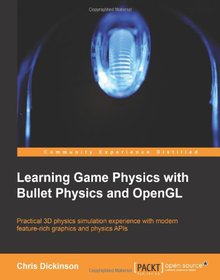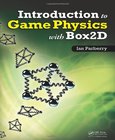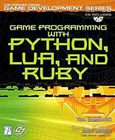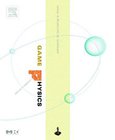Learning Game Physics with Bullet Physics and OpenGL

Book Details:
| Publisher: | Packt Publishing |
| Series: | Packt , Learning |
| Author: | Chris Dickinson |
| Edition: | 1 |
| ISBN-10: | 1783281871 |
| ISBN-13: | 9781783281879 |
| Pages: | 126 |
| Published: | Oct 25 2013 |
| Posted: | Nov 19 2014 |
| Language: | English |
| Book format: | |
| Book size: | 1.89 MB |
Book Description:
Practical 3D physics simulation experience with modern feature-rich graphics and physics APIs Overview Create your own physics simulations and understand the various design concepts of modern games Build a real-time complete game application, implementing 3D graphics and physics entirely from scratch Learn the fundamental and advanced concepts of game programming using step-by-step instructions and examples In Detail Physics simulation is an integral part of almost all game development projects as it is essential to the rules and feel of the game (gameplay) regardless of the project's scale. Bullet is a 3D Collision Detection and Rigid Body Dynamics Library for games, and special effects for film and animations. Bullet is integrated into many 3D modelers including Maya, Houdini, Cinema 4D, LightWave, and Blender. It is free for commercial use and open source under the permissive ZLib License. A comprehensive guide to start building games with the Bullet Physics library. Learn how modern physics engines work by implementing key features such as collision event systems, user input handling, and simulation of soft bodies. Then learn to control it all with forces, constraints, and robust object management. This book will reveal what's going on under the hood of two modern and feature-rich graphics and physics APIs; OpenGL and Bullet Physics. This book begins by teaching you to write your first OpenGL application, and then dives in to exploring the many features of the Bullet library in a straightforward manner. Each new feature expands upon the last, teaching you more about how physics is simulated in a video game, and how Bullet gives you the power to control every aspect of your simulation. You will learn how to render simple and complex shapes, apply some basic lighting, and construct a simple yet robust rendering system. From here, you will pull back the veil to see what's going on underneath Bullet Physics, and learn to implement key game logic features through this widely-used and extensive physics library. After you finish this book, you'll be armed with a wealth of knowledge to tackle the more advanced aspects of game graphics and physics going forward. What you will learn from this book Develop game applications from scratch; create a window, render the scene, and interact with your game through mouse and keyboard input Write OpenGL code at a low-level; render objects and understand every line of code you write! Understand how to keep the graphical and physical components of the simulation isolated for ease of understanding and future changes Learn how to properly handle the rendering and physics processing of multiple objects Explore the technologies and concepts behind modern game physics simulation through a practical understanding of Bullet Physics and OpenGL Build crucial features that are essential to all games; collision events, user input, object control, and trigger volumes Implement advanced physics simulation features like soft body physics, constraints, and collision filtering Delve into a robust and modern physics engine game; and understand the challenges and solutions the developers of Bullet built into the library Approach A comprehensive set of straight-forward, easy-to-follow tutorials in OpenGL and Bullet Physics that will teach you how modern game physics and 3D graphics work.
Download Link:
Related Books:
Introduction to Game Physics with Box2D
Written by a pioneer of game development in academia, Introduction to Game Physics with Box2D covers the theory and practice of 2D game physics in a relaxed and entertaining yet instructional style. It offers a cohesive treatment of the topics and code involved in programming the physics for 2D video games. Focusing on writing elementary game physics code, the first half of the book helps you grasp the challenges of programming game physics from scratch, without libraries or outside help. It examines the mathematical foundation of game physics and illustrates how it is applied in practice through coding examples. The second half of the book shows you how to use Box2D, a popular open source 2D game physics engine. A companion website provides supple...
Game Programming with Python, Lua and Ruby
Get ready to dive headfirst into the world of programming! "Game Programming with Python, Lua, and Ruby" offers an in-depth look at these three flexible languages as they relate to creating games. No matter what your skill level as a programmer, this book provides the guidance you need. Each language is covered in its own section?you'll begin with the basics of syntax and style and then move on to more advanced topics. Follow along with each language or jump right to a specific section! Similar features in Python, Lua, and Ruby?including functions, string handling, data types, commenting, and arrays and strings?are examined. Learn how each language is used in popular game engines and projects, and jumpstart your programming expertise as you...
Game Physics
Game Physics is an introduction to the ideas and techniques needed to create physically realistic 3D graphic environments. As a companion volume to Dave Eberly's industry standard 3D Game Engine Design, Game Physics shares a similar practical approach and format. Dave includes simulations to introduce the key problems involved and then gradually reveals the mathematical and physical concepts needed to solve them. He then describes all the algorithmic foundations and uses code examples and working source code to show how they are implemented, culminating in a large collection of physical simulations. This book tackles the complex, challenging issues that other books avoid, including Lagrangian dynamics, rigid body dynamics, impulse methods, resting co...
2007 - 2021 © eBooks-IT.org



